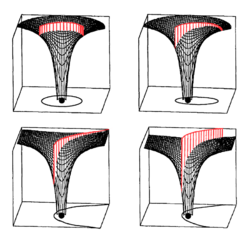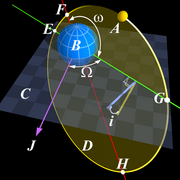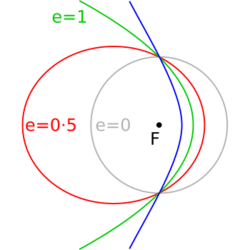Astronomy:Parabolic trajectory

| Part of a series on |
| Astrodynamics |
|---|
 |
In astrodynamics or celestial mechanics a parabolic trajectory is a Kepler orbit with the eccentricity equal to 1 and is an unbound orbit that is exactly on the border between elliptical and hyperbolic. When moving away from the source it is called an escape orbit, otherwise a capture orbit. It is also sometimes referred to as a C3 = 0 orbit (see Characteristic energy).
Under standard assumptions a body traveling along an escape orbit will coast along a parabolic trajectory to infinity, with velocity relative to the central body tending to zero, and therefore will never return. Parabolic trajectories are minimum-energy escape trajectories, separating positive-energy hyperbolic trajectories from negative-energy elliptic orbits.
Velocity
The orbital velocity ([math]\displaystyle{ v }[/math]) of a body travelling along a parabolic trajectory can be computed as:
- [math]\displaystyle{ v = \sqrt{2\mu \over r} }[/math]
where:
- [math]\displaystyle{ r }[/math] is the radial distance of the orbiting body from the central body,
- [math]\displaystyle{ \mu }[/math] is the standard gravitational parameter.
At any position the orbiting body has the escape velocity for that position.
If a body has an escape velocity with respect to the Earth, this is not enough to escape the Solar System, so near the Earth the orbit resembles a parabola, but further away it bends into an elliptical orbit around the Sun.
This velocity ([math]\displaystyle{ v }[/math]) is closely related to the orbital velocity of a body in a circular orbit of the radius equal to the radial position of orbiting body on the parabolic trajectory:
- [math]\displaystyle{ v = \sqrt{2}\, v_o }[/math]
where:
- [math]\displaystyle{ v_o }[/math] is orbital velocity of a body in circular orbit.
Equation of motion
For a body moving along this kind of trajectory the orbital equation is:
- [math]\displaystyle{ r = {h^2 \over \mu}{1 \over {1 + \cos\nu}} }[/math]
where:
- [math]\displaystyle{ r\, }[/math] is the radial distance of the orbiting body from the central body,
- [math]\displaystyle{ h\, }[/math] is the specific angular momentum of the orbiting body,
- [math]\displaystyle{ \nu\, }[/math] is the true anomaly of the orbiting body,
- [math]\displaystyle{ \mu\, }[/math] is the standard gravitational parameter.
Energy
Under standard assumptions, the specific orbital energy ([math]\displaystyle{ \epsilon }[/math]) of a parabolic trajectory is zero, so the orbital energy conservation equation for this trajectory takes the form:
- [math]\displaystyle{ \epsilon = {v^2 \over 2} - {\mu \over r} = 0 }[/math]
where:
- [math]\displaystyle{ v\, }[/math] is the orbital velocity of the orbiting body,
- [math]\displaystyle{ r\, }[/math] is the radial distance of the orbiting body from the central body,
- [math]\displaystyle{ \mu\, }[/math] is the standard gravitational parameter.
This is entirely equivalent to the characteristic energy (square of the speed at infinity) being 0:
- [math]\displaystyle{ C_3 = 0 }[/math]
Barker's equation
Barker's equation relates the time of flight [math]\displaystyle{ t }[/math] to the true anomaly [math]\displaystyle{ \nu }[/math] of a parabolic trajectory:[1]
- [math]\displaystyle{ t - T = \frac{1}{2} \sqrt{\frac{p^3}{\mu}} \left(D + \frac{1}{3} D^3 \right) }[/math]
where:
- [math]\displaystyle{ D = \tan \frac{\nu}{2} }[/math] is an auxiliary variable
- [math]\displaystyle{ T }[/math] is the time of periapsis passage
- [math]\displaystyle{ \mu }[/math] is the standard gravitational parameter
- [math]\displaystyle{ p }[/math] is the semi-latus rectum of the trajectory ([math]\displaystyle{ p = h^2/\mu }[/math] )
More generally, the time between any two points on an orbit is
- [math]\displaystyle{ t_f - t_0 = \frac{1}{2} \sqrt{\frac{p^3}{\mu}} \left(D_f + \frac{1}{3} D_f^3 - D_0 - \frac{1}{3} D_0^3\right) }[/math]
Alternately, the equation can be expressed in terms of periapsis distance, in a parabolic orbit [math]\displaystyle{ r_p = p/2 }[/math]:
- [math]\displaystyle{ t - T = \sqrt{\frac{2 r_p^3}{\mu}} \left(D + \frac{1}{3} D^3\right) }[/math]
Unlike Kepler's equation, which is used to solve for true anomalies in elliptical and hyperbolic trajectories, the true anomaly in Barker's equation can be solved directly for [math]\displaystyle{ t }[/math]. If the following substitutions are made
- [math]\displaystyle{ \begin{align} A &= \frac{3}{2} \sqrt{\frac{\mu}{2r_p^3}} (t - T) \\[3pt] B &= \sqrt[3]{A + \sqrt{A^{2}+1}} \end{align} }[/math]
then
- [math]\displaystyle{ \nu = 2\arctan\left(B - \frac{1}{B}\right) }[/math]
With hyperbolic functions the solution can be also expressed as:[2]
- [math]\displaystyle{ \nu = 2\arctan\left(2\sinh\frac{\mathrm{arcsinh} \frac{3M}{2}}{3}\right) }[/math]
where
- [math]\displaystyle{ M = \sqrt{\frac{\mu}{2r_p^3}} (t - T) }[/math]
Radial parabolic trajectory
A radial parabolic trajectory is a non-periodic trajectory on a straight line where the relative velocity of the two objects is always the escape velocity. There are two cases: the bodies move away from each other or towards each other.
There is a rather simple expression for the position as function of time:
- [math]\displaystyle{ r = \sqrt[3]{\frac{9}{2} \mu t^2} }[/math]
where
- μ is the standard gravitational parameter
- [math]\displaystyle{ t = 0\!\, }[/math] corresponds to the extrapolated time of the fictitious starting or ending at the center of the central body.
At any time the average speed from [math]\displaystyle{ t = 0\!\, }[/math] is 1.5 times the current speed, i.e. 1.5 times the local escape velocity.
To have [math]\displaystyle{ t = 0\!\, }[/math] at the surface, apply a time shift; for the Earth (and any other spherically symmetric body with the same average density) as central body this time shift is 6 minutes and 20 seconds; seven of these periods later the height above the surface is three times the radius, etc.
See also
References
- ↑ Bate, Roger; Mueller, Donald; White, Jerry (1971). Fundamentals of Astrodynamics. Dover Publications, Inc., New York. ISBN 0-486-60061-0. https://archive.org/details/fundamentalsofas00bate. p 188
- ↑ Zechmeister, Mathias (2020). "Solving Kepler's equation with CORDIC double iterations". MNRAS 500 (1): 109–117. doi:10.1093/mnras/staa2441. Bibcode: 2021MNRAS.500..109Z. Eq.(40) and Appendix C.
 |


